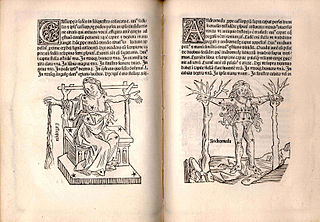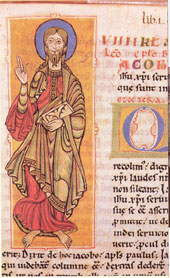The author and the time of creation of the work
Very little is known about the author of De munitionibus castrorum. According to the text, his work was intended to be a useful manual about how to properly lay out a military camp, specially written for a high-ranked officer:
- "novitatem metationis ad magnitudinem tuam primus adferam, quae tibi spero placebit, si primum cottidianam metationem tractabis" [2]
He also suggests that he was a beginner author and used other authors' works relevant to the theme:
- "In quantum potui, domine frater, pro tirocinio meo, in brevi omnes auctores sum persecutus, sed quidquid circa compositionem castrorum aestalivium instituerunt, in hoc libello, priusquam numeros instituerem, sub ratione omnia declaravi" [3]
The exact date of creation of the work is also uncertain. According to Domaszewski, it is certain that the work was not written before the time of the Roman emperor Trajan (it mentions Daci amongst the auxiliary forces), and was before the reforms of Diocletian (the Roman legion has its traditional structure). Domaszewski suggested that the image of the camp best fits the early second century AD, prior to the reforms of Hadrian.
Experts, however, still dispute the date, ranging from the earliest dating to the rule of Domitian.
It is also disputed whether such a large camp was ever built by the Romans. Archaeological finds clearly show that in actual practice a military camp was not always so regularly organized, as suggested by the author.
But, as he describes even the smallest part of the camp (including how much space is required for a soldier or a horse), it may be adopted to the requirements of the practice. He also mentions some general rules which must be considered when constructing a camp, although most of them are obvious (like a water source must be in the vicinity, etc.).
Aegle is the name of several different figures in Greek mythology:

The Lernaean Hydra or Hydra of Lerna, more often known simply as the Hydra, is a serpentine water monster in Greek mythology and Roman mythology. Its lair was the lake of Lerna in the Argolid, which was also the site of the myth of the Danaïdes. Lerna was reputed to be an entrance to the Underworld, and archaeology has established it as a sacred site older than Mycenaean Argos. In the canonical Hydra myth, the monster is killed by Heracles (Hercules) as the second of his Twelve Labors.
Gaius Julius Hyginus was a Latin author, a pupil of the scholar Alexander Polyhistor, and a freedman of Caesar Augustus. He was elected superintendent of the Palatine library by Augustus according to Suetonius' De Grammaticis, 20. It is not clear whether Hyginus was a native of the Iberian Peninsula or of Alexandria.
Sextus Julius Frontinus was a prominent Roman civil engineer, author, soldier and senator of the late 1st century AD. He was a successful general under Domitian, commanding forces in Roman Britain, and on the Rhine and Danube frontiers. A novus homo, he was consul three times. Frontinus ably discharged several important administrative duties for Nerva and Trajan. However, he is best known to the post-Classical world as an author of technical treatises, especially De aquaeductu, dealing with the aqueducts of Rome.
Pseudo-Philo is the name commonly used for the unknown, anonymous author of the Biblical Antiquities. This text is also commonly known today under the Latin title Liber Antiquitatum Biblicarum, a title that is not found in the Latin manuscripts. Although probably originally written in Hebrew, it is preserved today only through a Latin translation found in 18 complete and 3 fragmentary manuscripts that date between the eleventh and fifteenth centuries CE. In addition, material paralleling that in the Biblical Antiquities is also found in the Chronicles of Jerahmeel, a 14th-century Hebrew composition. The Latin text of the Biblical Antiquities circulated alongside Latin translations of the authentic writings of Philo of Alexandria. Scholars have long recognized the pseudonymous character of the text now known as the Biblical Antiquities. Primary in this regard is a vastly differing approach to and use of the Jewish scriptures. For the sake of convenience, scholars continue to follow the lead of Leopold Cohn in calling the unknown author "Pseudo-Philo".

In the Roman Republic and the Roman Empire, the Latin word castrum was a military-related term.

The Book of Abramelin tells the story of an Egyptian mage named Abraham, or Abra-Melin, who taught a system of magic to Abraham of Worms, a Jew in Worms, Germany, presumed to have lived from c. 1362 to c. 1458. The system of magic from this book regained popularity in the 19th and 20th centuries partly due to Samuel Liddell MacGregor Mathers' translation, The Book of the Sacred Magic of Abramelin the Mage.

Theophilus Presbyter is the pseudonymous author or compiler of a Latin text containing detailed descriptions of various medieval arts, a text commonly known as the Schedula diversarum artium or De diversis artibus, probably first compiled between 1100 and 1120.

Gromatici or agrimensores was the name for land surveyors amongst the ancient Romans. The "gromatic writers" were technical writers who codified their techniques of surveying, most of whose preserved writings are found in the Corpus Agrimensorum Romanorum.

De astronomia is a book of stories written in Latin, probably during the reign of Augustus. Attributed to "Hyginus", the book's true author has been long debated. However, the art historian Kristen Lippincott argues that the author was likely Gaius Julius Hyginus, who served as the superintendent of the Palatine library under Caesar Augustus.

The Corpus Agrimensorum Romanorum is a Roman book on land surveying which collects works by Siculus Flaccus, Frontinus, Agennius Urbicus, Hyginus Gromaticus and other writers, known as the Gromatici or Agrimensores. The work is preserved in various manuscripts, of which the oldest is the 6th or 7th-century Codex Arcerianus.

The Codex Calixtinus is a manuscript that is the main witness for the 12th-century Liber Sancti Jacobi, a pseudepigraph attributed to Pope Calixtus II. The principal author or compiler of the Liber is thus referred to as "Pseudo-Calixtus", but is often identified with the French scholar Aymeric Picaud. Its most likely period of compilation is 1138–1145.

Pseudo-Apuleius is the name given in modern scholarship to the author of a 4th-century herbal known as Pseudo-Apuleius Herbarius or Herbarium Apuleii Platonici. The author of the text apparently wished readers to think that it was by Apuleius of Madaura (124–170 CE), the Roman poet and philosopher, but modern scholars do not believe this attribution. Little or nothing else is known of Pseudo-Apuleius.
Hyginus, usually distinguished as Hyginus Gromaticus, was a Latin writer on land-surveying, who flourished in the reign of Trajan. Fragments of a work on boundaries attributed to him are found in Corpus Agrimensorum Romanorum, a collection of works on land surveying compiled in Late Antiquity.
Duncan B. Campbell is a scholar of Greek and Roman warfare. He published his first paper in 1984, as an undergraduate at the Glasgow University, Scotland, and produced a complete re-assessment of Roman siegecraft for his PhD. Besides academic articles, he has written several other popular books about ancient warfare, chiefly siegecraft, published by Osprey Publishing. He is a regular contributor to Ancient Warfare magazine and a frequent reviewer for Bryn Mawr Classical Review. He has published a new edition, with English translation, of the Roman military source known as the Liber de munitionibus castrorum, and a new edition, with English translation and detailed commentary, of the Ektaxis kat' Alanōn of Arrian.
Pseudo-Hyginus may refer to:
Siculus Flaccus was an ancient Roman gromaticus, and writer in Latin on land surveying. His work was included in a collection of gromatic treatises in the 6th century AD.
Aggenus Urbicus was an ancient Roman technical writer appearing in the Corpus Agrimensorum Romanorum, a collection of works on land surveying from Late Antiquity. It is uncertain when he lived, but he may have been a Christian living in the later part of the 4th century, judging by expressions he uses.

Codex Carolinus is an uncial manuscript of the New Testament on parchment, dated to the 6th or 7th century. It is a palimpsest containing a Latin text written over a Gothic one. The Gothic text is designated by siglum Car, the Latin text is designated by siglum gue or by 79, it represents the Old Latin translation of the New Testament. It is housed in the Herzog August Library in Wolfenbüttel in Lower Saxony, Germany.

A military treatise or treatise on war is any work that deals with the "art of war" in some basic aspect. Fundamentally military treatises are treatises on military strategy. Other works may also be included in the definition that, although they deal with other topics, include sensitive information about military matters. These may include, among others, description of specific battles, sieges, general campaigns, reports of military authorities, and commented works about ground or naval battles.










